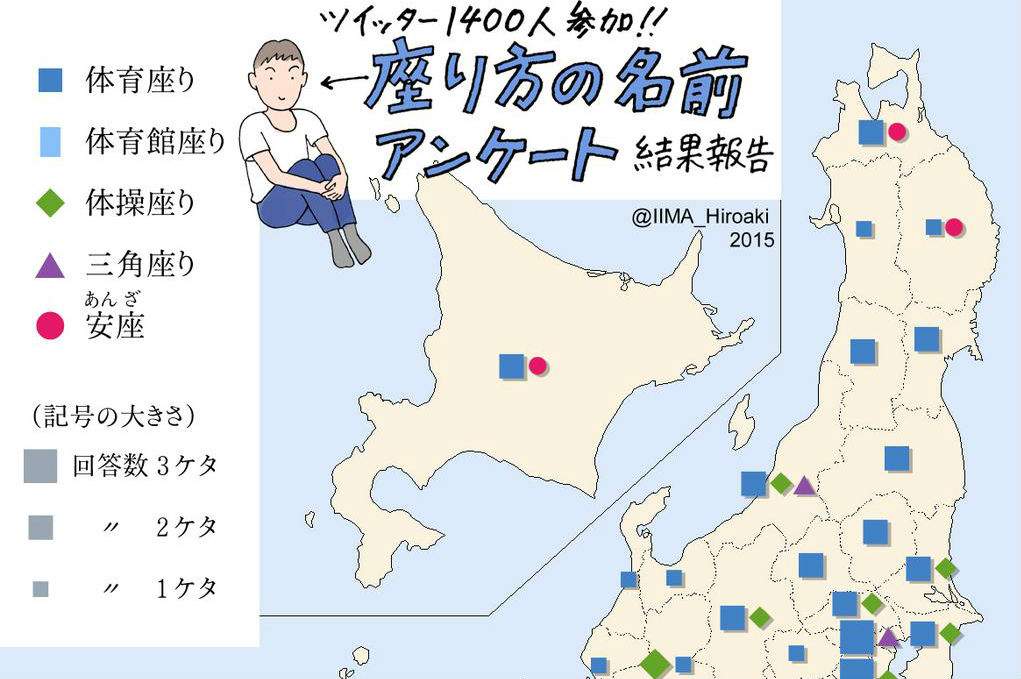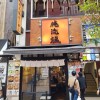
Even when speaking with fellow English speakers, sometimes you realize that the same thing can be called a variety of names. (Try calling soda “pop” in most of the US and enjoy the funny looks you get.) The same is true in Japan, where, thanks to regional dialects, some people have a hard time being understood when they leave their hometowns.
One Twitter user recently brought regional dialect differences to the forefront of the Internet when he surveyed over a thousand people about the word they would use to describe a certain way of sitting. Collecting and plotting the data on a map of Japan, the results have been surprising people from all regions!
On the evening of May 1, Twitter user Hiroaki Iima posted a tweet asking his followers and other users to complete a quick survey. He asked them simply to reply with the word they would use to describe the way the boy in the accompanying picture is sitting and include the region of Japan in which they learned this word. Easy.
▼ What would you call this style of sitting in English?
小アンケートにご協力くださいませんか。添付の画像のような座り方を、あなたは何と言いますか。このツイートにリプライの形でお答えいただければ幸いです。付加情報もあればお願いします。結果は、のちにまとめてご報告します。 pic.twitter.com/7oHL0O4Ytj
— 飯間浩明 (@IIMA_Hiroaki) May 1, 2015
It was so easy, in fact, that he received 600 responses in just two hours and over 800 in eight hours. When he closed the survey at 8:30 AM on May 2, just 10 hours later, he’d received nearly 1,400 answers from all over Japan.
His next task was to tally all of the answers and plot them on a map of Japan. This way, it would be easy to tell which words are used in different regions.
▼ He’s pretty dedicated to this project to input all of this data…
「座り方の名前アンケート」、本格的に集計中です。わりあいはっきりした傾向が出るのではないかな、と見込んでいます。なお、調査自体は終了しています。 pic.twitter.com/NvDayD1ef1
— 飯間浩明 (@IIMA_Hiroaki) May 2, 2015
Before we explain the results, it’s important to note that this style of sitting is the posture enforced in most schools in Japan during both P.E. classes and assemblies held in the gymnasium.
▼ There are lots of blue squares…
「座り方の名前アンケート」の結果報告です。ご協力感謝します。調査締切後も回答が多く寄せられたため、午後2:00までの分をまとめてマップを作成。「体育座り」のほか「体操座り」「三角座り」「安座」などの地域差が明確に出ました。 pic.twitter.com/4yHVcb24TM
— 飯間浩明 (@IIMA_Hiroaki) May 2, 2015
Mr. Iima found that there are five different names commonly used for this style of sitting:
Darker blue square: Tai-iku suwari (“P.E. sitting”)
Light blue rectangle: Tai-iku kan suwari (“Gymnasium sitting”)
Green rhombus: Taisou suwari (“Calisthenics sitting”)
Purple triangle: Sankaku suwari (“Triangle sitting”)
Red circle: Anza (“Sitting quietly/sitting cross-legged”)
On the map, the size of the symbol reflects the number of responses for that word. Almost every region had replies mentioning “Tai-iku suwari (P.E. sitting)”, however the differences in dialect were also very common and obvious by region: “Taisou suwari (calisthenics sitting)” is the second most commonly used term and is used in a variety of areas. Kansai is dominated by “Sankaku suwari (triangle sitting),” although it pops up in a couple of other prefectures, as well. Kochi Prefecture is apparently the only region to use “Tai-iku kan suwari (gymnasium sitting),” and “Anza (sitting quietly/ sitting cross-legged)” is used exclusively in Tohoku.
A few other words for the same posture came out in the survey too, although they are less commonly used:
“S-gata suwari” (S-shaped sitting) –Gunma
“Hako suwari” (Box sitting) -Saitama
“Yama suwari” (Mountain sitting) -Nagano and Kagawa
“Ohiza dakko” (Hugging knees sitting) -Shizuoka
“くno jigata” (Shape of the character ku), “Daruma sitting” -Osaka
“Hakutosan suwari” (A mountain in North Korea) -North Korean school [???]
“Dai 2 no shisei” (Second posture) -Nagasaki
After all of Iima’s research, data input and map-making, we found out that if you said “Tai-iku suwari,” pretty much everyone in the country would understand what you’re talking about. Still, seeing the differences in dialect that exist alongside the common word is pretty interesting.
If you live, work or went to school in Japan, what do you call this position? Are there any other Japanese words you know that are often different in other areas? Also, if you want to learn more about Japanese dialects, you can always learn how to say “I love you” in all 47 prefectures of Japan!

 Five words that sound completely different across Japanese regional dialects
Five words that sound completely different across Japanese regional dialects North Japan prefecture creates guide to help new foreign workers understand local language quirks
North Japan prefecture creates guide to help new foreign workers understand local language quirks A rice by any other name: Japanese Twitter investigates local terms for “serving”
A rice by any other name: Japanese Twitter investigates local terms for “serving” How to say “I love you” in Japanese – 47 different ways 【Videos】
How to say “I love you” in Japanese – 47 different ways 【Videos】 New Pokémon Line app message stamps raise money for children in Japan’s disaster-struck regions
New Pokémon Line app message stamps raise money for children in Japan’s disaster-struck regions Red light district sushi restaurant in Tokyo shows us just how wrong we were about it
Red light district sushi restaurant in Tokyo shows us just how wrong we were about it Japanese ramen restaurants under pressure from new yen banknotes
Japanese ramen restaurants under pressure from new yen banknotes McDonald’s new Happy Meals offer up cute and practical Sanrio lifestyle goods
McDonald’s new Happy Meals offer up cute and practical Sanrio lifestyle goods Tokyo Tsukiji fish market site to be redeveloped with 50,000-seat stadium, hotel, shopping center
Tokyo Tsukiji fish market site to be redeveloped with 50,000-seat stadium, hotel, shopping center Beautiful Red and Blue Star luxury trains set to be Japan’s new Hokkaido travel stars
Beautiful Red and Blue Star luxury trains set to be Japan’s new Hokkaido travel stars Akihabara pop-up shop sells goods made by Japanese prison inmates
Akihabara pop-up shop sells goods made by Japanese prison inmates Starbucks Japan adds a Motto Frappuccino to the menu for a limited time
Starbucks Japan adds a Motto Frappuccino to the menu for a limited time Sakura tree falls on man at Sannenzaka near Kiyomizu temple in Kyoto 【Breaking News】
Sakura tree falls on man at Sannenzaka near Kiyomizu temple in Kyoto 【Breaking News】 Pokémon Sleep camping suite and guestrooms coming to Tokyo Hyatt along with giant Snorlax burgers
Pokémon Sleep camping suite and guestrooms coming to Tokyo Hyatt along with giant Snorlax burgers Non-ramen Ramen Restaurant Stars: The quest begins at Tokyo’s Oreryu Shio
Non-ramen Ramen Restaurant Stars: The quest begins at Tokyo’s Oreryu Shio All-you-can-drink Starbucks and amazing views part of Tokyo’s new 170 meter-high sky lounge
All-you-can-drink Starbucks and amazing views part of Tokyo’s new 170 meter-high sky lounge More foreign tourists than ever before in history visited Japan last month
More foreign tourists than ever before in history visited Japan last month French Fries Bread in Tokyo’s Shibuya becomes a hit on social media
French Fries Bread in Tokyo’s Shibuya becomes a hit on social media Studio Ghibli releases new action figures featuring Nausicaä of the Valley of the Wind characters
Studio Ghibli releases new action figures featuring Nausicaä of the Valley of the Wind characters New private rooms on Tokaido Shinkansen change the way we travel from Tokyo to Kyoto
New private rooms on Tokaido Shinkansen change the way we travel from Tokyo to Kyoto Starbucks reopens at Shibuya Scramble Crossing with new look and design concept
Starbucks reopens at Shibuya Scramble Crossing with new look and design concept Studio Ghibli glasses cases let anime characters keep an eye on your spectacles
Studio Ghibli glasses cases let anime characters keep an eye on your spectacles Beautiful Ghibli sealing wax kits let you create accessories and elegant letter decorations【Pics】
Beautiful Ghibli sealing wax kits let you create accessories and elegant letter decorations【Pics】 Studio Ghibli releases Kiki’s Delivery Service chocolate cake pouches in Japan
Studio Ghibli releases Kiki’s Delivery Service chocolate cake pouches in Japan New definition of “Japanese whiskey” goes into effect to prevent fakes from fooling overseas buyers
New definition of “Japanese whiskey” goes into effect to prevent fakes from fooling overseas buyers Our Japanese reporter visits Costco in the U.S., finds super American and very Japanese things
Our Japanese reporter visits Costco in the U.S., finds super American and very Japanese things Studio Ghibli unveils Mother’s Day gift set that captures the love in My Neighbour Totoro
Studio Ghibli unveils Mother’s Day gift set that captures the love in My Neighbour Totoro New Japanese KitKat flavour stars Sanrio characters, including Hello Kitty
New Japanese KitKat flavour stars Sanrio characters, including Hello Kitty New Pokémon cakes let you eat your way through Pikachu and all the Eevee evolutions
New Pokémon cakes let you eat your way through Pikachu and all the Eevee evolutions Disney princesses get official manga makeovers for Manga Princess Cafe opening in Tokyo
Disney princesses get official manga makeovers for Manga Princess Cafe opening in Tokyo Sales of Japan’s most convenient train ticket/shopping payment cards suspended indefinitely
Sales of Japan’s most convenient train ticket/shopping payment cards suspended indefinitely Sold-out Studio Ghibli desktop humidifiers are back so Totoro can help you through the dry season
Sold-out Studio Ghibli desktop humidifiers are back so Totoro can help you through the dry season Japanese government to make first change to romanization spelling rules since the 1950s
Japanese government to make first change to romanization spelling rules since the 1950s Ghibli founders Toshio Suzuki and Hayao Miyazaki contribute to Japanese whisky Totoro label design
Ghibli founders Toshio Suzuki and Hayao Miyazaki contribute to Japanese whisky Totoro label design Doraemon found buried at sea as scene from 1993 anime becomes real life【Photos】
Doraemon found buried at sea as scene from 1993 anime becomes real life【Photos】 Tokyo’s most famous Starbucks is closed
Tokyo’s most famous Starbucks is closed One Piece characters’ nationalities revealed, but fans have mixed opinions
One Piece characters’ nationalities revealed, but fans have mixed opinions We asked a Uniqlo employee what four things we should buy and their suggestions didn’t disappoint
We asked a Uniqlo employee what four things we should buy and their suggestions didn’t disappoint Princesses, fruits, and blacksmiths: Study reveals the 30 most unusual family names in Japan
Princesses, fruits, and blacksmiths: Study reveals the 30 most unusual family names in Japan Only one out of five Japanese people can pronounce these hiragana — can you?
Only one out of five Japanese people can pronounce these hiragana — can you? Baseball players like Frozen too: “Let It Go” chosen for Spring Koshien baseball tournament
Baseball players like Frozen too: “Let It Go” chosen for Spring Koshien baseball tournament Kansai and Kanto prove again that they are each distinct regions when it comes to food
Kansai and Kanto prove again that they are each distinct regions when it comes to food New Miyazaki Pref. tourism ad gets laughs with the incomprehensible dialect of an ancient god
New Miyazaki Pref. tourism ad gets laughs with the incomprehensible dialect of an ancient god Real-life location of Your Name’s anime-only lake discovered, still holds a beautiful surprise
Real-life location of Your Name’s anime-only lake discovered, still holds a beautiful surprise Customer gets more than expected after ordering the large size at a Japanese restaurant
Customer gets more than expected after ordering the large size at a Japanese restaurant “We wasted so much time in English class” — Japanese Twitter user points out major teaching flaw
“We wasted so much time in English class” — Japanese Twitter user points out major teaching flaw Japanese readers rave about new book illustrating differences between Kanto and Kansai regions
Japanese readers rave about new book illustrating differences between Kanto and Kansai regions The awesome artwork hiding in the Japanese word processor: sakura, dragons, and sake
The awesome artwork hiding in the Japanese word processor: sakura, dragons, and sake Don’t know which sake to drink? These handy flavor charts help you pick by region of Japan
Don’t know which sake to drink? These handy flavor charts help you pick by region of Japan 11 different ways to say “father” in Japanese
11 different ways to say “father” in Japanese Squat toilets’ popularity fading as parents call for them to be abolished in Japanese schools
Squat toilets’ popularity fading as parents call for them to be abolished in Japanese schools 7 things that surprise a visitor to Laos 【Photos】
7 things that surprise a visitor to Laos 【Photos】 Iketara iku: A simple Japanese phrase that people in Tokyo and Osaka take completely differently
Iketara iku: A simple Japanese phrase that people in Tokyo and Osaka take completely differently Japan fans call Rugby World Cup player Luke Thompson “kawaii” for the way he speaks Japanese
Japan fans call Rugby World Cup player Luke Thompson “kawaii” for the way he speaks Japanese Secret staff cafeteria in Osaka is one of Japan’s best-kept secrets
Secret staff cafeteria in Osaka is one of Japan’s best-kept secrets
Leave a Reply